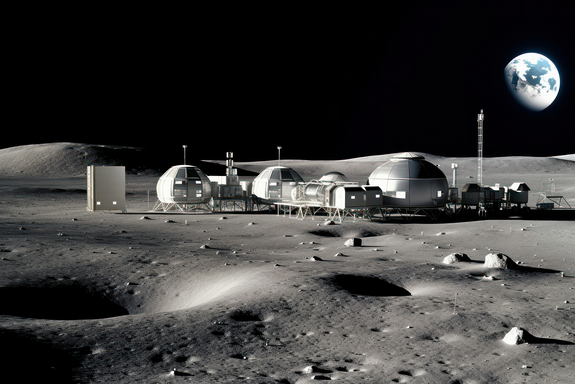Executive MBA


Welcome to the TU Wien Academy for Continuing Education, where we provide a comprehensive range of lifelong learning opportunities for professionals, academics and executives. Our mission is to empower our students with top-tier education and training, enabling them to excel in their chosen fields.
A Guide to Leadership in Space Architecture

As humanity approaches the era of multi-planetary habitation, space architecture emerges as a crucial discipline, a task requiring visionary leaders.
In this field, engineering, science and imagination merge, and leaders are tasked with designing structures in extreme environments that redefine human existence. As a space architecture leader, you'll guide skilled professionals in groundbreaking projects, creating innovative and sustainable designs, and innovative solutions for extreme challenges.
Collaborate with experts across diverse industries, pushing boundaries and unlocking untapped potential. Seize the opportunity to become part of an elite group of trailblazers who will shape the future of human civilization on our planet.
Are you ready to embrace the challenge of a leadership role in the world of space architecture? Now is the time to explore this extraordinary career path.
Space architecture is an interdisciplinary field that focuses on the design, planning, and construction of habitable environments in outer space but also includes extreme Environments on Earth. It encompasses a wide range of considerations, from the physical and psychological needs of astronauts in extreme environments to the unique challenges posed by the space environment itself, such as microgravity, radiation, and extreme temperatures.
Space architects work at the intersection of engineering, science, and design, creating innovative solutions that enable humans to live, work, and thrive beyond Earth's atmosphere, eg. in a space station. This rapidly evolving discipline is essential for the successful expansion of human civilization into the cosmos.
A space architect is responsible for designing and planning habitable environments beyond Earth's atmosphere, encompassing life support systems and human habitation in extreme environments. This requires a deep understanding of human needs, material science, engineering principles, terrestrial architecture, and the unique challenges presented by space travel.
As a space architect, you will work closely with aerospace engineers, scientists, and other experts to develop innovative solutions that ensure the safety and comfort of astronauts during long-term missions. Your designs will not only be aesthetically pleasing but also highly functional, addressing issues like radiation protection, microgravity adaptation, resource management, and adapting terrestrial architecture to suit extreme environments. Ultimately, your work as a space architect will be essential in laying the foundation for humanity's expansion into the cosmos.
In the rapidly evolving field of space architecture, effective management and leadership are crucial for driving innovation and ensuring the success of ambitious projects. As a leader in space architecture, you will be responsible for guiding interdisciplinary teams, making strategic decisions, and navigating the complex challenges of designing and constructing habitable environments in space.
Leaders in space architecture must possess strong communication and collaboration skills, as they typically work closely with experts from various fields, including aerospace engineering, materials science, and human factors. They must also be adept at managing resources, timelines, and budgets, ensuring that projects are completed on time and within scope.
Pursuing a leadership role in space architecture is an excellent career choice for those who are passionate about space exploration and eager to make a lasting impact on the future of human civilization. This path is well-suited for professionals with backgrounds in engineering, science, design, or management who are looking to combine their expertise and contribute to the development of innovative space habitats and technologies.
The space industry is blossoming with private companies such as SpaceX, Blue Origin, and others entering the arena, expanding the horizons and possibilities for space architects. From designing lunar landers that will touch down on the moon's surface to conceptualizing habitats for Mars, the opportunities are as boundless as space itself.
Graduates of space architecture programs can explore a variety of career paths and employment sectors, including:
Aerospace Companies: Work with leading aerospace companies like SpaceX, Blue Origin, and Boeing, contributing to the design and development of spacecraft, lunar landers, and space habitats.
Government Agencies: Join organizations like NASA, ESA, or other national space agencies, collaborating on space exploration missions and the development of space infrastructure.
Research Institutions: Contribute to cutting-edge research at universities and research centers, advancing the field of space architecture and developing innovative solutions for space habitation.
Consulting Firms: Provide expert advice to clients in the space industry, helping them navigate the complexities of designing and building structures for space environments.
Startups: Launch or join a space-focused startup, working on innovative projects that push the boundaries of space architecture and exploration.
Sustainable Design: Apply the principles of space architecture to sustainable design on Earth, creating eco-friendly and resource-efficient buildings and infrastructure.
Academia: Educate the next generation of space architects, sharing your knowledge and expertise at universities and educational institutions.
After activation, data may be transmitted to third parties. Data protection declaration., opens in new window
Space Architecture's Future: Brent Sherwood & Blue Origin's Vision
Brent Sherwood, a renowned space architect and educator as well as faculty member of TU Wien's Executive MBA Space Architecture, as he discusses the evolution of space architecture and his 'four Futures' model in this comprehensive talk.
Space architecture requires a unique set of skills that span across various disciplines. Prospective architects must be adept in advanced design techniques, have a solid grounding in aerospace engineering principles, and a deep understanding of the challenges posed by the space environment. Specialized programs like the Executive MBA in Space Architecture at TU Wien ACE are designed to equip students with these interdisciplinary skills. "t's evident that the role of leaders in space architecture is crucial in driving innovation and successfully executing complex projects. Space architects must not only possess deep knowledge in engineering, science, and design but also demonstrate proficient skills in project management and interdisciplinary collaboration.", says Prof. Sandra Häuplik-Meusburger, Academic Director of the MBA in Space Architecture.
The innovative solutions and technologies developed for space habitation also have the potential to address Earth's sustainability challenges. Techniques for recycling air and water, energy-efficient building designs, and support for the use of non-traditional materials are just a few examples of space architecture's earthbound benefits. By leveraging the knowledge gained from space architecture, we can develop technologies that enable a more sustainable future for our planet.
Prof. Häuplik-Meusburger adds, that "many principles of space architecture can also have a positive impact on Earth. By applying knowledge of space technologies and concepts, we can explore potential solutions for challenges such as climate change and resource scarcity, demonstrating that space exploration not only expands human horizons but also enhances life on our planet."
Space architecture principles, honed from experiences like the construction of the International Space Station, can be applied to the design of disaster-resistant structures on Earth. By incorporating materials and techniques used in space habitats, such as those found in the Space Station, into terrestrial architecture, architects can create buildings that withstand extreme weather conditions, earthquakes, and other natural disasters. This not only ensures the safety of occupants but also reduces the need for costly repairs and reconstruction efforts.
The resource constraints faced by space habitats demand innovative solutions for efficient resource management. By applying these principles to Earth-based architecture, we can create buildings that minimize waste and optimize the use of resources such as water, energy, and materials. This approach can lead to significant cost savings and a reduced environmental impact, contributing to a more sustainable future.
Space architecture often relies on modular and adaptable design principles to accommodate the changing needs of astronauts and space missions. By incorporating these concepts into Earth-based architecture, we can create flexible spaces that can be easily reconfigured or expanded as needed. This adaptability not only enhances the functionality of buildings but also extends their lifespan, reducing the need for new construction and minimizing waste.
The Executive MBA Space Architecture is a unique program designed to equip you with the interdisciplinary skills and knowledge necessary to excel in this rapidly growing field. This part-time program spans three semesters, culminating in a Master's Thesis, and awards 92 ECTS credits upon completion. The curriculum is delivered in English and includes a study trip to Houston, USA.
During the whole program at the TU Wien, you will have the opportunity to meet astronauts and gain first-hand insights from opinion leaders in space research and industry.
Throughout the program, you will engage in modules focused on Management & Technology Essentials, Leadership & Organizational Behavior, and the Masterclass Space Architecture - Life in Space on Earth. This comprehensive curriculum prepares you for an international and interdisciplinary management role, developing innovative concepts with international partners and addressing the unique challenges of the extreme space environment.
Prof. Häuplik-Meusburger invites interested professionals to take a closer look: "I encourage all those dreaming of pursuing a career in space architecture to have the courage to take the first step. With the Executive MBA in Space Architecture at TU Wien ACE, we offer the ideal platform to expand your knowledge, develop your skills, and turn your passion for space exploration into reality".
The Executive MBA in Space Architecture is the perfect choice for professionals from various backgrounds who wish to combine science, technology, and creativity in their work, as well as those already established in the space sector looking to advance into management or leadership positions.
Embarking on beginning a career in space architecture requires a bold step forward. TU Wien ACE offers the guidance and knowledge necessary to begin this journey. Prospective students can reach out to the admissions team, attend informational webinars, and connect with alumni to start their path to becoming space architects.
The field of space architecture is a beacon for those who look to the stars and the moon and yearn to contribute to humanity's next great venture. It's a career that promises not just a job, but an adventure—a chance to leave an indelible mark on the future of human civilization.
02. February 2024, 16:41 until
Other